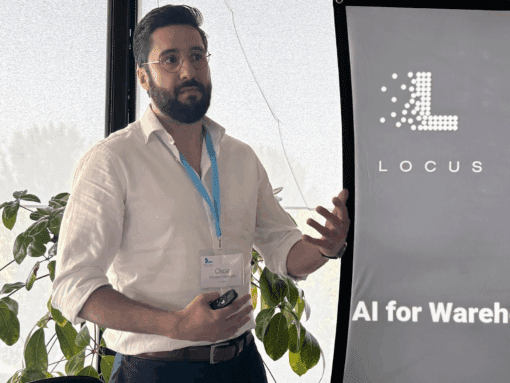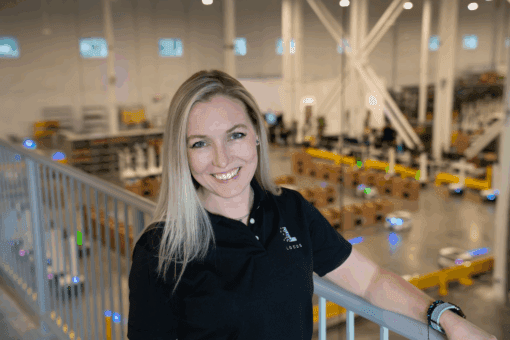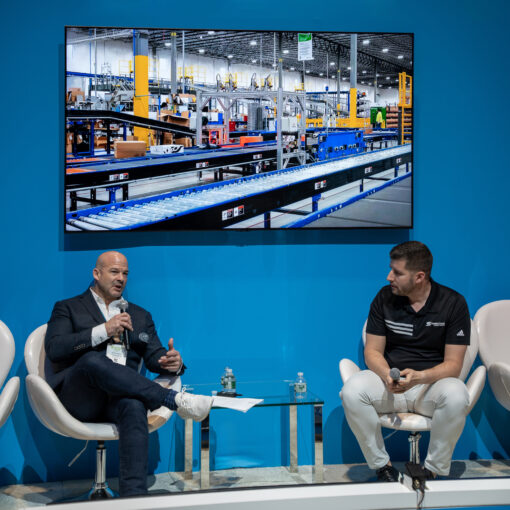WP: How to achieve 400 UPH with Locus Fast Pick
WP: How to achieve 400 UPH with Locus Fast Pick Download Now!
Building Long-Term Customer Relationships in Warehouse Automation
Jasmine Lombardi, Chief Customer Officer

Trust isn’t built overnight. It takes time, consistency, and a genuine commitment to helping customers succeed. At Locus Robotics, long-term customer relationships don’t just happen. We cultivate them through trust, communication, listening, and an unwavering focus on solving real warehouse challenges.
Why Listening is Important to Customer Relationships
Warehouse operations are complex, and no two facilities are identical. The key to being a trusted partner and forming a long-term customer relationship is listening — really listening — to what customers experience on the floor. That means paying attention not just to how robots fit into warehouse workflows but also to adjacent processes that impact efficiency.
For example, when visiting a site, we don’t just focus on how workers induct totes onto robots. Instead, we look at everything leading up to that moment. Are employees taking unnecessary steps? Can ergonomics be improved? If we see workers hauling heavy totes across long distances, we ask: What if Locus Vector handled that transport instead? It’s this kind of holistic approach, where we look beyond the immediate task to optimize the entire process, that strengthens our relationships and reinforces our role as a solutions provider, not just a robotics vendor.
Beyond immediate workflow improvements, listening also allows us to uncover larger operational challenges. For instance, a fulfillment center might be struggling with high labor turnover, inefficient inventory management, or unpredictable seasonal demand spikes. By listening and engaging in meaningful conversations, we can identify patterns and develop strategies to address these broader issues. This proactive approach demonstrates our commitment to their long-term success, not just their immediate needs.
Earning Trust Through Collaboration
Building trust with customers is about working alongside the warehouse to solve problems instead of just telling them what to do. That requires clear communication and a willingness to adapt. When our team identifies inefficiencies, we don’t just recommend changes; we explain the benefits. For example, take something as simple as repositioning pack stations. If a warehouse is picking orders faster than they can be packed, the process breaks down and becomes a bottleneck. By assessing the entire flow, we help customers reconfigure their stations, ensuring that packing keeps pace with picking.
Customers appreciate that we’re not just focused on deploying robots but on improving overall operations. That trust grows when they see firsthand that our team, which can include Customer Success Managers (CSMs), Optimization and Solution Designers (OSDs), and/or Deployment Project Managers (DPMs), is invested in their long-term success.
Our ability to adapt to each warehouse’s specific needs further solidifies these relationships. In some cases, that means making small operational tweaks that have strong impacts on efficiency. In others, it involves providing strategic guidance on major workflow overhauls. By working as an extension of their team, we ensure that customers always feel supported and confident in their automation investments.
Continuous Optimization Beyond Deployment
Deploying automation is just the beginning. Once a system is live, our focus shifts to continuous improvement. We track metrics against KPIs at key milestones — 15, 30, 45, and 60 days post-deployment — to measure efficiency gains and identify areas for optimization. But numbers alone don’t tell the full story. Our team stays engaged, checking in regularly to ensure operations are running smoothly and proactively addressing any bottlenecks. By monitoring trends and working with customers, we help them rebalance workloads, implement different waving strategies, inventory slotting strategy, streamline packing, and keep operations running efficiently.
We also recognize that change management is an essential part of successful automation adoption. Customers don’t always have the capacity to overhaul every process at once, which is why we prioritize incremental improvements. During deployment, we focus on the most impactful changes first, ensuring teams can quickly see the benefits. Once operations stabilize, we continue to optimize workflows and recommend additional refinements to drive further efficiency gains. This phased approach makes change more manageable and helps ensure long-term adoption.
A Data-Driven Approach to Optimization
The best warehouse automation isn’t static. It evolves as business needs change and that’s why we take a data-driven approach to ongoing optimization. By continuously analyzing key performance indicators (KPIs) like dwell time, volume throughput, and pick rates, we identify trends and recommend adjustments to maintain peak performance.
For example, if we notice a sudden dip in productivity, we don’t just assume it’s an operational issue. We work with customers to determine the cause, whether it’s a temporary inventory disruption, a staffing change, or an unexpected surge in order volume. This proactive monitoring ensures that challenges are addressed before they escalate into major problems.
Our commitment to continuous improvement extends beyond individual warehouse operations. By leveraging insights from a broad range of customer deployments, we identify best practices and share them across our network. This collective knowledge allows us to provide customers with industry-leading guidance and ensure they’re always positioned for success.
A Commitment to Long-Term Success
Warehouse automation is about deploying technology and then helping customers achieve lasting operational improvements. By focusing on open communication, solving real problems, and staying engaged beyond deployment, we have built lasting partnerships with some of the world’s leading fulfillment operations.
The strongest customer relationships are built on trust, problem-solving, and a shared commitment to success. That’s why we work alongside our customers to ensure they achieve their goals, today and in the future. From deployment to long-term optimization, we’re there every step of the way, helping warehouses maximize efficiency, minimize downtime, and adapt to changing demands.
BIO:
Jasmine Lombardi brings more than 25 years of experience in customer success, professional services, software development, project management, global systems implementation, and business operations. She leads a team of over 110 customer success professionals across North America, Europe, the UK, and Australia. Prior to Locus, Jasmine held senior leadership roles at Barracuda Networks, Intronis, Aspen Technology, Mzinga, Prospero Technologies, and PAREXEL International, where she built a strong foundation in delivering customer value and operational excellence. She has earned numerous awards, including Mass High Tech’s 2014 Women to Watch, CRN Women of the Channel and Power 100 (2016), and a Gold Stevie Award for Customer Service Leader of the Year (2016). Most recently, she was honored as one of the Top 50 Women Leaders in Boston for 2024. Jasmine holds a Bachelor of Science in Computer Science from the National University of Singapore, a Master of Science in Information Systems from Boston University and is a certified Project Management Professional (PMP).




